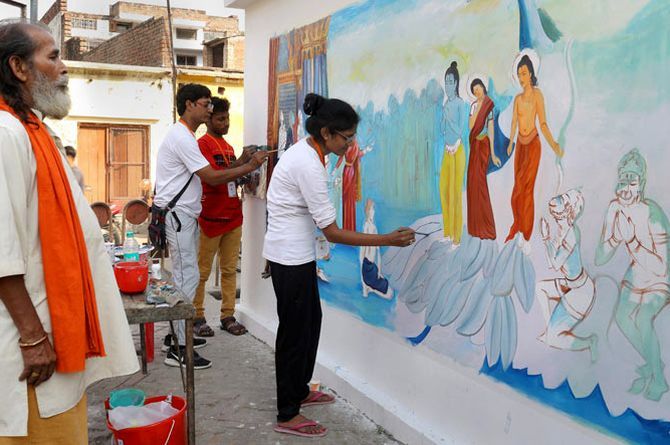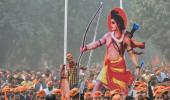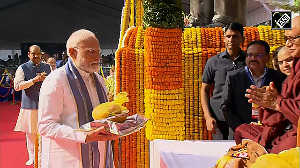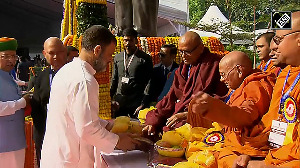By pegging the exact area of the Babri Masjid site at 0.313 acres, and not the original 2.77 acres, the government hopes to be in line with the court ruling in the 1994 Ismail Faruqui case which mentions return of land to original claimants once the exact area needed for acquisition is determined, observes Saisuresh Sivaswamy.

Faced with seeming judicial reluctance to handle the Ram Janambhoomi-Babri Masjid title case ahead of the general election due in less than 100 days on one hand, and a restive Hindu right-wing as well its own support base on the other, the Narendra Damodardas Modi government on Tuesday, January 29, moved an application before the Supreme Court seeking the transfer of the undisputed part of the land acquired in Ayodhya in 1993 to the Ram Janambhoomi Nyas.
Here's the history behind the acquired land in Ayodhya.
Following the demolition of the Babri Masjid on December 6, 1992, the following month the P V Narasimha Rao government passed the Acquisition of Certain Area at Ayodhya Ordinance which was subsequently converted into an Act of Parliament, under which the government acquired the 67 acre plot in Ayodhya, which included the disputed site admeasuring 2.77 acres.
The extra land around the site, which was undisputed, was acquired to facilitate ingress and egress to pilgrims whenever the court case was settled and any shrine came up at the site.
In the petition filed by Dr Ismail Faruqui challenging the validity of this law, a five judge bench of the Supreme Court in October 1994 not only upheld the Rao government's legislation but also stated that 'a mosque was not an essential part of the practice of Islam' and hence its acquisition by the government was not barred by the Constitution of India.
Importantly, it struck down the abatement of all legal suits in the Ayodhya matter, thus reviving litigation over the title deed to the disputed site.
Undeterred by this setback, the Ram Janambhoomi Nyas, which owned as much as 42 acres of undisputed land covered by the Ayodhya Act, in 1996 moved an application before the government seeking the return of its land, but it was turned down.
The Nyas then filed a suit before the Allahabad high court, but it was rejected there as well.
During the National Democratic Alliance government headed by Atal Bihari Vajpayee, the Vishwa Hindu Parishad tried to whip up sentiments over the Ram mandir by performing puja at the undisputed part of the acquired land.
That effort was foiled by a cycle-rickshaw shop-owner, Mohammed Aslam Bhure, moved the Supreme Court seeking a stay on any religious activity in the entire acquired land.
On March 31, 2003, the apex court granted Aslam Bhure's prayer, ruling that no part of the land can be touched till the main dispute was disposed of.
In 2010, the Allahabad high court, hearing four civil suits, ruled that the 2.77 acre disputed land be partitioned equally among three parties -- the Sunni Wakf Board, Ram Lalla and the Nirmohi Akhara.
Fourteen appeals have since been filed in the Supreme Court against this judgment, which the apex court has been in the process of hearing.
The latest hearing was to have taken place on Tuesday, January 29, the day the government moved an application seeking to overturn the 2003 Aslam Bhure judgment, but it was deferred on Sunday, January 27, following the non-availability of a judge on the day.
Interestingly, the government's plea further divides the disputed area in the Ayodhya suit.
It said that of the 2.77 acres of disputed land, the Babri Masjid occupied only 0.313 acres and that this was the actual disputed site. The plea bundled the rest of the disputed site with the undisputed area of land around it, and asked the apex to release 67.390 acres of land to its original owners.
In seeking to nullify the Aslam Bhure judgment, the Centre has relied on the Supreme Court order in the Ismail Faruqui case, where it said: '...However, at a later stage when the exact area acquired, which is needed for achieving the professed purpose of acquisition, can be determined, it would not merely be permissible but also desirable that the superfluous excess area is released from acquisition and reverted to its earlier owner.'
'In case the superfluous area is not returned to its owner even after the exact area needed for the purpose is finally determined, it would be open to the owner of any such property to then challenge the superfluous acquisition being unrelated to the purpose of acquisition.'
It is in this context that the mention of 0.313 acres and not 2.77 acres as the exact area occupied by the Babri Masjid needs to be viewed. By thus determining the exact area, the government hopes to be in line with the court ruling in the 1994 case.
It remains to be seen if the Supreme Court will buy into this contention. The question, of course, is when.












 © 2025
© 2025